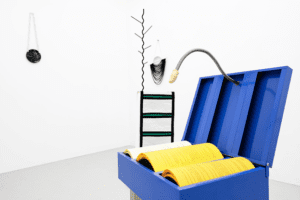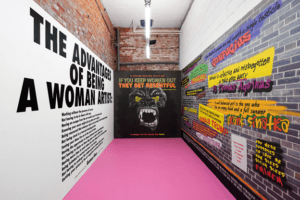by Viktor Witkowski in Berlin

In 2018, Laetitia Gorsy opened up her gallery She BAM! in the Spinnerei, located in the East German city of Leipzig. Over three decades, the Spinnerei – a former late 19th-century cotton factory – has become a hub for artists, galleries, residencies, other cultural institutions and ventures attracting tens of thousands of visitors from across the world each year.
There is no other gallery like it: owned by a woman, operated by women and exhibiting only women artists. Laetitia, who is a French national, studied modern literature before she switched to graphic design. While working on her M.A., she developed collaborative projects by creating self-published books, fanzines and newspapers. Soon she was circulating and exhibiting books by placing them in bookshops and book fairs. In 2014, she was selected for a French curator-in-residence project called Generator at the 40m Cube. After her move to Germany, she started working at a commercial gallery in Leipzig. During the same period, she enrolled in the curatorial studies program at the HGB Leipzig (Academy of Fine Arts Leipzig). When the gallery permanently shut its doors two years later, Laetitia Gorsy used it as an opportunity to come up with her own concept by addressing a void in the global art market.
Describe what She BAM! is and when you first decided to bring it to life.
LG: She BAM! is an art gallery that exclusively represents women artists, an all-women gallery. The program is international and the desire is to join forces with artists and collaborators to showcase the diversity that current artistic practices can represent. She BAM! is multilingual and works with emerging, mid-career and established artists from France, Germany, Russia, Sweden, Poland, the US. Outside the exhibition program, She BAM! collaborates with women who work in the world of art including design, graphic design, publishing, fashion, as well as other people who support women across artistic fields. She BAM! sometimes takes the form of a ‘hub’ or ‘think-tank’ by organizing events, talks, round tables and workshops. She BAM! intends to support and manage women artists and their careers. It is an initiative that believes in the importance of women who create spaces for other women without competition, without malice. It stands for a continuity of sharing, a transfer of power.
After having worked for almost a decade in the art world, the need to create a place like She Bam! became abundantly clear to me. I wanted to find a solution to the underrepresentation of women working in leading positions in galleries, museums, and art fairs – as though women are unable to undertake anything serious. She Bam! was born out of a necessity to change the present situation. This commitment is political and social. But it is also important to underline that my engagement with artworks and artists’ concepts is not limited by She BAM!’s broader agenda. It is not a question of offering exclusively ‘feminist’ exhibitions, but rather to show a variety of artistic practices independent of their content.
According to a September 19th, 2019 article on artnet.com, the market for work by women doubled over the past decade. But the sales of work by women account for only two percent of total art sales between 2008 and the first half of 2019. Some people in the art world think that they can already congratulate themselves for promoting women artists, but these numbers suggest that there is still a lot of work ahead of us. Do you believe that She BAM! can address this disparity and how so? What else needs to be done to achieve equality in the arts?
LG: Women artists have been marginalized and under-represented; art history has been written by men, for men. Men and their money also dominate the art market. This creates a situation that is not easy to manage. To operate within this system, you have to stay strong in the face of these pressures produced by men and their money. You have to be aware of the art world’s failures and operate around these circumstances. It’s embarrassing when I hear that investing in a woman is bad business. To get out in front of these problems, you really have to dig in, unmask the system, have courage, be patient, resist and denounce these abuses of power.
I believe in the possibility of generous and open networks for artists and dealers that do not compete with each other. It’s true that not everyone can work together, and I admit that the idea of a global network seems complicated. The idea is above all to support each other to build professional alliances, to give each other a chance to speak up and be heard, to share experiences with people who feel the same way and to put ourselves in a position where we can trust each other.

Even though She BAM! is not a project space, it is not a traditional gallery either. You organize exhibitions that take place in changing locations in Leipzig, Paris and other cities. In this way, She BAM! offers more flexibility for its artists, their work, and the various art-viewing publics you reach. Are you proposing a new gallery format? And if so, how can we expect She BAM! to develop and grow in the future?
LG: Maybe I just don’t like to follow what people or art professionals expect me to do. I follow my feelings and take time to reflect on the conditions that I am facing. Once I get a sense for a potential project, I either go for it or not. But what I don’t want is to be stuck in a box, because I prefer to experiment as much as possible.
Any new gallery format poses opportunities and challenges, but maybe it is more about adapting the format to the actual world: being flexible, unexpected, dynamic. I am curious how it will evolve and grow. I want it to become big of course! I want to support artists and advance their careers and create bridges and connections beyond borders. I also intend to build a tightly knit and dynamic She BAM! team. At the same time, I want to retain my ability to work independently and follow my vision.
How do you seek out and pick artists? And what are your responsibilities as curator?
LG: When I decide to work with an artist, it is a mix of something that attracts me: coincidence, intuition, an encounter and a vision that I want to realize. I have to believe in it and be able to defend it. It is also important to me to have a good feeling about, and a meaningful relationship with, an artist in order to trust each other.
My responsibilities go beyond just being a curator. It is about being the founder of the gallery, being responsible for all communications, the sales, being responsible for the conditions that I create for the artist, including any fees for transport and travel as well as production costs, etc. This has to be taken seriously. As soon as you defend a practice or work by an artist, you are invested, and you should work hand in hand with the artist until the end of the process. In some cases, you might have to halt a collaboration, because it is better for both sides. But in general, my goal with She BAM! is to offer the best possible exhibition conditions for my artists and help them to develop their practice in new ways. I also provide close support to the artists throughout the process of putting together a show – from guiding their vision to displaying it. I think of each exhibition as a collaboration. My responsibility is also to promote each exhibition to the public and its supporters. All in all, I shoulder the entire project of She BAM! and try to keep it moving to a new level each time!
Earlier this year you organized an exhibition with the Guerrilla Girls that ran from January 11th through the 15th of February in Leipzig. How did this show come about and are there other established artists that you are planning to work with?
LG: That appeared to me as something essential and urgent! I first learned about the Guerrilla Girls when I was taking art history classes a long time ago in college. When I was an art student, I was looking at their work with admiration and respect. Then, last year, I saw one of their works in São Paulo, at the MASP (The São Paulo Museum of Art ) in the Lina Bo Bardi display, and I decided that I had to do a show with them at She BAM!. I saw it as my responsibility to show their iconic work at the gallery – as a reminder, as necessity, as something we have to keep in mind moving forward with our discourse on equality. I also wanted to show them outside their regular exhibition context which tends to be museums or blue-chip galleries. Of course, I work with many emerging artists and artists from my own generation, but I am totally into working with more established and mid-career artists. This goes with my idea of intersectionality, diversity and, yes: there are already several projects in the pipeline.

Several artists who you work with are either based in Leipzig or studied in Leipzig at the HGB (Leipzig Academy of Fine Arts). In what ways does Leipzig and its artists differ from cities like Paris, London or Berlin? What do you think needs to change in Leipzig and what can other cities learn from it?
LG: Leipzig interests me because it is challenging. I saw the gradual change of the city when I went there in 2012 for the first time. I can’t say how it is different to Paris, London or Berlin, except that I find it a very good platform where you can develop works and ideas without the stress of working and living in a metropolis. Every city has its own vibe. For me, it is more a question of destiny: I came to Leipzig with the intention to eventually leave. But now, I have learned to like Leipzig. I don’t really know what other cities can learn from it, but I think Leipzig has learned from other places as there is an influx of people from different parts of the country and from abroad. I like to uphold my outsider status in this city; it allows me to keep a distance to its art scene. I also have the same feeling when I am in France, since I am traveling back and forth between both countries.
The art worlds in Germany and France are very different from each other. For instance, art professionalism plays a different role in both countries. In France, art schools are becoming aware that it is their responsibility to not only support students’ practice, but to prepare them for their career as professionals. And a lot of young, recently graduated French art students have trouble turning their practice into a career. I wouldn’t say that it works better in Germany, but there are more artist-run spaces by students for example and other such initiatives which demonstrate a robust interaction between students and the professional art world. In France, the government allocates less funds to artists. Social and health care benefits are also quite chaotic, bureaucratic and in need of reforms. In Germany, the Arts are perhaps considered a more essential aspect of society. In general, Germans seem to take it more seriously: as a profession rather than just a romantic idea. But generalizations aside: in the end, it is all about nuances and the distinct ways in which each culture approaches art.
It’s a real advantage to help artists with their professional growth and defend women artists.
She BAM! is very active in Leipzig but it also has a presence in France. For example, I have been working on a program with pop-up events in France and I maintain a close relation to art professionals based there. I think Leipzig is important, but She BAM! is not connected to a specific place: I want it to be immaterial and everywhere.
Anything else you want to share?
LG: It is hard to say, but to think of equality as something that only concerns a minority of people is very sad. Whenever this question is raised, people start thinking more about equality. But equality should not just be supported because it is the fashionable thing to do at any given moment. The increased attention paid to women artists could become a more common phenomenon within the next few years. But as soon as you stop fighting for their visibility, that tendency might dissipate, and patriarchal domination returns like mould on a wall. No one will ask you to fight for women and minorities’ rights, but if you commit to doing it, you have to continuously keep up the pressure to keep it alive.
Volume 34 no 6 July / August 2020
